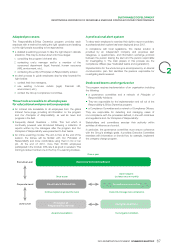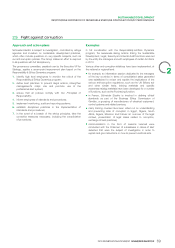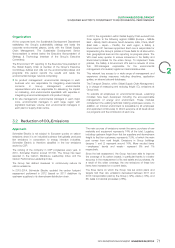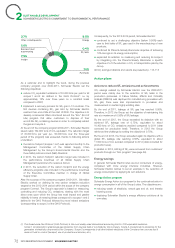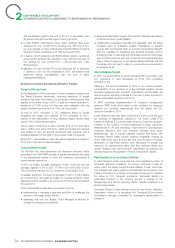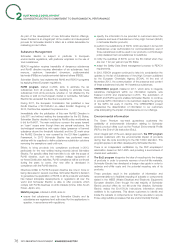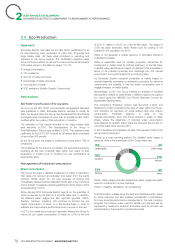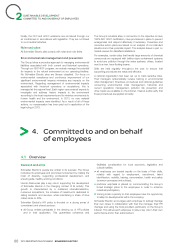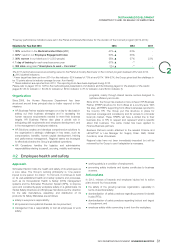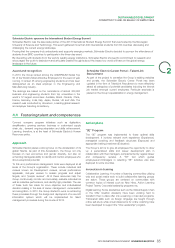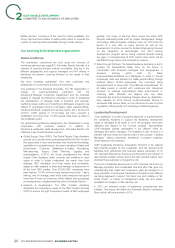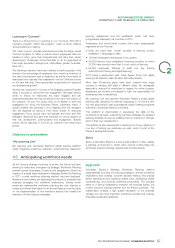APC 2013 Annual Report Download - page 79
Download and view the complete annual report
Please find page 79 of the 2013 APC annual report below. You can navigate through the pages in the report by either clicking on the pages listed below, or by using the keyword search tool below to find specific information within the annual report.
SUSTAINABLE DEVELOPMENT
SCHNEIDER ELECTRIC’S COMMITMENT TO ENVIRONMENTAL PERFORMANCE
Eco-Design Strategy
as to minimize environmental footprint in order to offer products
and solutions today in accordance with the principles of
By focusing its efforts to improve the environmental footprint of its sustainable development. In effect, plastic is present in almost all
offerings on the protection of people and the environment, climate Schneider Electric products and the amount of CO2 equivalents
change and resource scarcity while addressing environmental needed to produce the plastic is estimated at 550,000tons per
issues with its suppliers and its manufacturing processes and year. The Green Plastic program is carried out in collaboration with
logistics, Schneider Electric consolidated its Eco-design strategy in the businesses and the teams in charge of material purchasing and
line with its Environment policy in 2012. Schneider Electric, by design, and is part of the Group’s actions for sustainable
enforcing its EcoDesign policy, is committed to: development.
reduce the environmental impact of its products and solutions
l
The program follows a unique strategy for each type of plastic
throughout their lifecycle;
2
focusing around three successive progress plans. A “green” plastic
therefore design products and solutions that respect the
l
must therefore:
environment through a continuous improvement ecodesign
be exempt from potentially toxic substances and have an1.
approach;
end-of-life evaluation scenario that respects the environment
involve its suppliers and partners in the continuous improvement
l(material or energy); during 2013, a project has been
process to minimize the upstream supply chain impacts;
successfully managed to design an alternative monomer for
styren based composite materials. Additionally post
measure and communicate to all stakeholders in its extended
l
consumer recycled plastics from WEEE origin have been
supply chain about the environmental impact of the company’s
successfully formulated to enable rigid PVC specification;
offer.
come from a production sector that has low CO2 use2.
Compliance with WEEE and equivalent legislation (recycled plastic or plastic from renewable sources) and be
capable of limiting fossil fuel demand as well as energy and
A number of political commitments and regulations address the
water; during 2013, two range of innovative plastics –
issue of waste from electrical products. One example is the
respectively from renewable origin and from recycled origin –
European Waste Electrical and Electronic Equipment directive
have been validated for wire and devices offer (socket,
(WEEE), which has been transposed into law in each Member
outlets);
State. Similar regulations have been adopted or initiated in Japan,
come from a resource that does not compete with the food3.
China, India and the United States.
sector either directly or indirectly, in the case that the Green
The WEEE directive’s main objective is to increase the recovery
Plastic solution makes good use of a raw material from a
rate for the largest types of electrical waste, such as televisions,
renewable source. Schneider Electric is now involved in a
refrigerators and lighting systems, as well as for short-lived IT and
collaborative project called Polywood and based on cellulose
telecommunication equipment. Industrial electrical and electronic
bio refinery. Such a project is dedicated to enable sugar
devices and electrical distribution equipment are only very
based building blocks for performance polymer without food
marginally concerned as of now. Under the directive, the
competition.
equipment manufacturer is responsible for setting up and financing The added value that customers expect from “green” plastics lies
dedicated solutions to collect and process discarded equipment. in two major areas:
The directive sets minimum rates for recovery and recycling.
applications exempt from substances of very high concern,
l
Schneider Electric is actively involved in a responsible approach particularly including non-PVC and non-halogen flame retardant
even though virtually none of its products are covered by the plastics product ranges;
directive.
energy efficient or electric vehicle offers that use plastics with a
l
As a responsible company, Schneider Electric must be able to very low environmental impact.
prove the existence of established end-of-life solutions. These Schneider Electric uses a partnership approach in order to make
must be financed and certified for collecting, processing and progress in research in this area. The Group therefore participates
recycling end-of-life products in a way that respects both human in collaborative platforms such as the Paristech Mines Bioplastics
health and the environment. Chair, the Axelera competitive clusters initiative (in sustainable
Carried out in close cooperation with all Group partners, the chemistry), the Plastipolis cluster (in plastics engineering) and the
approach is deployed at the national level in each host country. POLYNAT Carnot Institute. Co-development approach with best in
This involves identifying, certifying and in some cases organizing class suppliers is also a very fruitful approach.
solutions for processing waste from electrical equipment, with the By actively participating in the Polywood project, Schneider Electric
application of the appropriate indicators. has solidified its commitment to bio-plastics from non-food
Green Plastic Program
resources. Under the acronym Polywood, this collaborative project
encompasses the development of a bio-refinery fueled by wood
The aim of this technological innovation program is to develop next by-products provided by the paper industry.
generation plastic having in mind to improve health profile as well
77
2013 REGISTRATION DOCUMENT SCHNEIDER ELECTRIC


